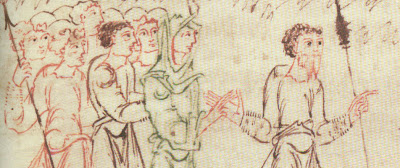The Old English Genesis (The Junius Manuscript)

This is post # 6 in my series on the Sackler exhibit: "In the Beginning: Bibles before the Year 1000"; for the preceding post (# 5), click here.
The next book that caught our eye as we toured the Sackler exhibit was The Old English Genesis, otherwise known as The Junius Manuscript. This work, stemming from England (Canterbury?) of about 1000 ce, consists of rare Old English poetic paraphrases of biblical narratives, particularly of Genesis. As you can see from my photo (above; click to enlarge), the poetry is accompanied by a series of illustrations of Genesis, drawn in red, blue, and green inks. (Actually, the books has sketches and drawings by two different artists using two different color-sets and styles.)
Here (see photo above) on p. 84 of the book we have three key scenes from Genesis 12, early in the Abraham story. In the top scene from Gen 12:1-3, God (with a halo but no beard) uses vivid gestures to call Abraham out of Haran. Sarah and Lot watch from Abraham's house. In the middle scene, the company of Abraham makes the journey to Canaan. In the bottom scene, which illustrates Gen 12:7, the Lord reappears to Abraham, saying, "To your descendants I will give this land."

In this detail that I've made of the left side of the middle register, you can see Abraham guiding his whole entourage, including Sarah and Lot, out of Haran and toward Canaan. Abraham's and Sarah's hands seem to interconnect, but Abraham looks determinedly forward, and his left hand, holding a spear, also seems to point in the direction of God's promised land.
0 Comments:
Post a Comment
<< Home